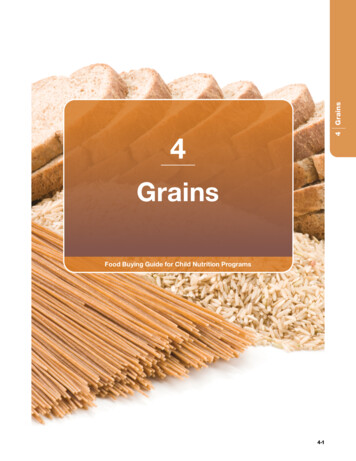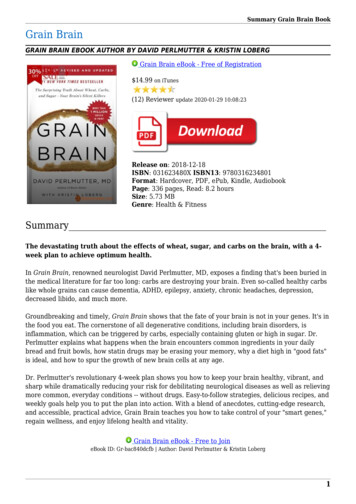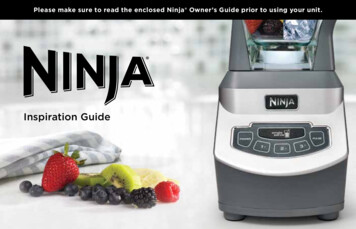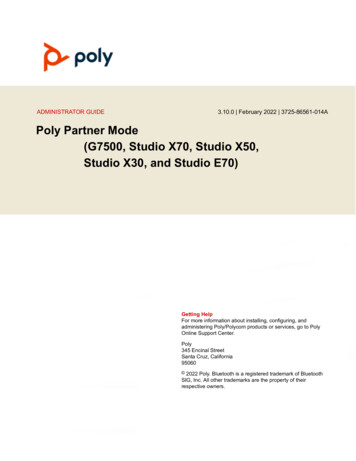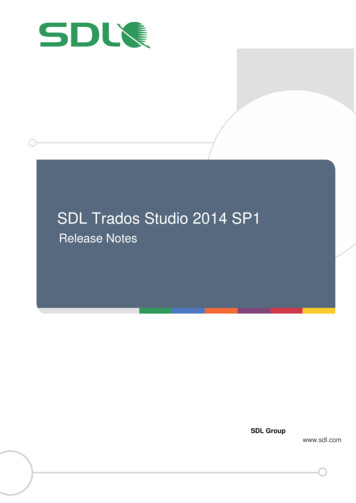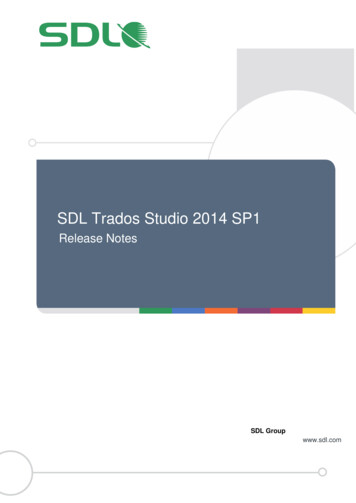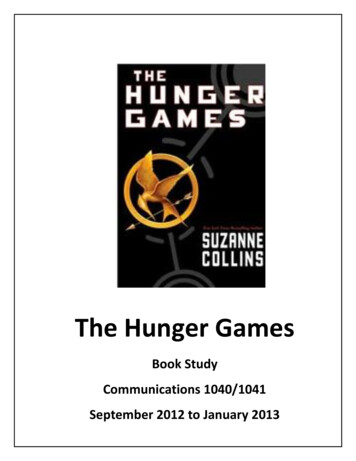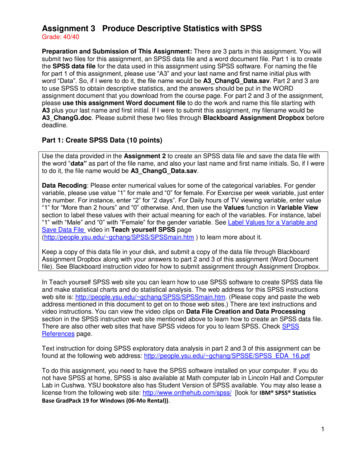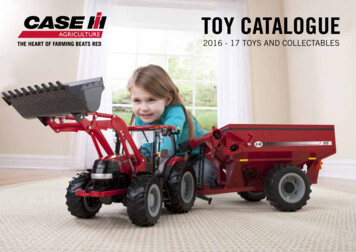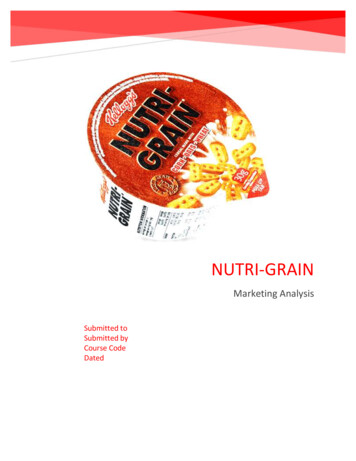
Transcription
NUTRI-GRAINMarketing AnalysisSubmitted toSubmitted byCourse CodeDated
1 INTRODUCTIONNutri-Grain is a brand of Kellogg’s Company in Northern Hemisphere. Especially in New Zealand andAustralia, Nutri-Grain is a popular breakfast cereal that is made from wheat, corn and oats. The originalNutri-Grain breakfast in “block and hole” shape was marketed in Australia in 1976 and 1981 (Kellogg's,2016). The previous wheat breakfast cereal were made up of sugar and flakes. There were four types ofcereal available at start including rye, barley, wheat and corn. The bars of Nutri-Grain became popularduring 1990s in Australia while Nutri-Grain breakfast drinks were recently added into line of cereals in2013 (Kellogg's, 2016).2 SITUATION ANALYSISThe situation analysis of Kellogg’s Nutri-Grain is given below.2.1 LEVELS OF COMPETITIONThe top competitors of Kellogg’s Nutri-Grain cereal are shown in the figure below:Figure 1: Major Players in Cereal IndustrySource: (IBISWorld, 2016)
2.1.1Product FormProduct form of competition is about the competitive products with similar product features and samecompeting market (Lehmann & Winer, 2008). At this level, the competitors offer similar goods andcompete for the same turf (IBISWorld, 2016). Under this level of competition, Nutri-Grain has followingcompetitors: Weeties General Mill Holdings Milo Energy Cereal Uncle Toby's Oats Golden Vale Sanitarium2.1.2Product CategoryProduct category competition expands to include the competitive products with similar featuresregardless of any market segment (Lehmann & Winer, 2008). Under this level of competition, NutriGrain has following competitors: Australian Health & Nutrition Association Nestle The Uncle Tobys Company Pty Ltd Freedom Foods2.1.3GenericGeneric form of competition is the one that includes all competing products but are unrelated to givenproduct (Lehmann & Winer, 2008). These products fulfill equivalent wants and needs. Under this level ofcompetition, Nutri-Grain has following competitors: Quaker Oats Company Unigrain Australia Monster Health Food Co. Dorset Cereals
McCain Foods Prestige Food manufacturing Jewel Fine Food Vesco Foods2.1.4BudgetBudget competition is the outermost level of competition that involves the products that compete forsame consumer dollar. Under this level of competition, Nutri-Grain has following competitors: Many competitors selling different kinds of cereals at different price points ranging from as lowas AUD3.19.2.2 CATEGORY ANALYSISThe category analysis of Kellogg’s Nutri-Grain is given below:2.2.1Category Size and GrowthThe Breakfast and Cereal Industry of Australia is facing stagnancy as Australians are now choosinghealthier cereals and snacking option that has reduced the value share of two major cereal industryplayers i.e. Nestle and Kellogg’s. According to Euromonitor International reports, in 2010 Kellogg’s(Australia) had a cereal market share of 40% which dropped down at 27% in 2014. Similarly the valueshare of Nestle also dropped from 27% in 2013 to 25% in 2014 (Euromonitor, 2016). However, a 39%increase in sales of hot cereals was recognized whereas muesli’s sales grew by 27% in the past six years.Based on data trend of 2007-2012, the Australian Bureau of Statistics indicates that Australian Cerealsand Bakery sector will continue to increase in value at CAGR of 1.3% between 2012 till 2017(Euromonitor, 2016). This rising number of consumption is due to Australians focus on healthier life stylewith much focus on low fat, low calorie and low cholesterol products.
Figure 2: CAGR of Ready to Eat Foods in Australia (2007-2012 trend)Source: (Euromonitor, 2016)2.2.2Channel AnalysisKellogg’s possesses a well-equipped and leading storage system for ensuring that products reach thecustomers in best quality. Kellogg’s annual report (2015) presented that one of the greatestopportunities for growth in the country is to expand geographically along with acquisition of new highpotential channels of distribution. Sydney’s new café launch by Kellogg’s is an example of such step.Kellogg’s follow intensive distribution system for ensuring that all of its products including Nutri-Grainare widely distributed and is in reach of everyone. Kellogg’s has been achieving saturation coveragethrough contracting with local distributors and retailers like Tesco, Walmart, Dunnes and ASDA fordistributing its products especially Special K and Nutri-Grain Bars (Kellogg's, 2015).2.2.3Stage of the Product Life CycleThe product life cycle is based on four mains stages i.e. introduction, growth, maturity and decline(Stark, 2015). Nutri Grain’s prime purpose was to allow the eaters to have quick breakfast in short time.Convenience and healthy ingredients underpinned the product (Kellogg's, 2015). During introductionstage, Nutri Grain became successful after being recognized as the most popular breakfast cereal.During market growth stage, the sales grow at faster rate while industry profits reach higher rates.Advertisement plays major role in growth stage while competitors keep on entering the market. At thispoint customers tend to see the product everywhere and gain more knowledge about the product. InAustralia and New Zealand, Nutri-Grain became a popular breakfast cereal made from corn, wheat and
oats. In 2002, Nutri-Grain’s sales increased as the product was promoted as a popular healthy breakfastalternative. The sales improved due to development of flavors. The market position of the Nutri-Grainalso re-established at all-day healthy snack. In the maturity phase, the profits are at maximum andbrand name is built. Kellogg’s All Bran Bars and other manufacturer’s Alpen Bars started facing slowersales and ate away some of Nutri-Grains market position. Right now, Nutri-Grain cereal is at declinestage where the products lose its value to customers and a resolution related to redesigning,reformulating or repackaging of product is required. In 2005, Kellogg’s extended the life of Nutri-Grainby repackaging and reformatting the product at 3 million marketing strategy (MARSD, 2017). However,currently Kellogg’s is operating in an oligopoly market with being at mature life cycle stage.2.2.4PEST AnalysisPEST analysis is undertaken to review the political, economic, social and technological (PEST) factorsaffecting the products and firms operating within an economy (Fullen & Podmoroff, 2006). A PESTanalysis correlates the external factors with success of a particular company or industry with asubsequent business (Fullen & Podmoroff, 2006). The PEST analysis of Nutri-Grain is given below:2.2.4.1PoliticalKellogg’s needs to adhere to exportation and importation of the boards under Australian New ZealandFood Standards Code for regulating a proper cereal manufacturing.2.2.4.2EconomicCereal industry grows with high usage of cereal along with affordable prices.2.2.4.3SocialReady to eat cereals have emerged out to be effective in servicing the busiest lifestyles of manycustomers. Cereals are also becoming popular as companies are advertising the health benefits that areassociated with eating breakfast.2.2.4.4TechnologicalTechnology is also used more to harvest the wheat that helps in producing cereals. Moreover cerealshave emerged out to be highly computerized industry that is seeking new advancements for reducingcarbon footprints.
2.3 COMPANY AND COMPETITIVE ANALYSIS2.3.1Product Features and Analysis MatrixComponentPriceVarietyWeightValue PropositionPromotionUncle Toby’s Lift 4.99Protein Lift and SportsLift460 gramsHas real plump, fruitsand nutsCelebrity Endorcementthrough EmilySeebohm and GrantHackettSanitarium WeetBix 4.19Kids, Oats, Barley andMulti-grain750 gramsFavorite cereal ofAustralians from past40 yearsOfficial sponsors ofSocceroos and WeetBixkids try AthlonsMilo Energy Cereal 4.98Milo Duo and EnergyCereal350 gramsMade with wholegrainand fiber to delivergreat nutritionMilo in cricket andcelebrity endorsement
3 SEGMENTATION AND TARGET MARKET ANALYSISMarket segmentation is defined by Hutt and Speh (2009) as a group of present or optional customersthat have common characteristics. The segmentation and target market analysis for Nutri-Grain Cerealsis given below:3.1 SEGMENTATION ANALYSISThe cereal market of Australia can be broadly segmented into four main categories namely Sweet Tooth,Healthies, Body Watchers and Energy Junkies. Nutri-Grain is a cereal that is opted and consumed bythose customers that value nutrition over every other attribute of product. “Healthies” segment,particularly is the main segment that is interested in nutritional value of cereals that helps inmaintaining overall well-being. On the other hand, “Sweet Tooth” customers are the ones that consumecereals based on taste. This segment is dominated by kids between ages of 5 years to 12 years.Moreover, “Body Watchers” segment consists of conscious women that are extremely confident and fallin the age bracket of 25 to late 30s. Lastly, the “Energy Junkies” segment is the one that enjoys activelifestyle and is involved heavily into sports and exercise. Segmentation summary is given in the tablebelow.BehaviorSweet ToothHealthiesTasty CerealHighBody WatchersEnergy JunkiesSegmentationBenefitNutritional Maintain WeightTake EnergyValueKnowledgeof Medium to HighHighHighMedium to HighLowMediumLow(Only Breakfast)(Only Breakfast)ProductUsageLow-Medium(Snackingand (Only Breakfast)Breakfast)LoyaltyHighMediumLowLowPrice SensitivityLowLowLowLow
DemographicSweet ToothHealthiesBody WatchersEnergy JunkiesChildrenAdultsWomenGrowing Kids andSegmentationLife CycleAdultsAge5 to 1330s to 40s25 to late 35s12 to 25PsychographicSweet ToothHealthiesBody WatchersEnergy JunkiesLifestyleCare h25 to late 35s 12ConsciousnessModernSegmentationBrandFrootLoops, Weetbix,Specialto25Energetic/outgoingKby Nutri-grain,Frosted Chocolate Multigrain, OatsKelloggs, Light ‘n’ Weetbix,Flakes, Coco PopstastyMilo,by Uncle Toby’s PlusSanitarium3.2 TARGET MARKETThe target market for Nutri-Grain in Australia will be Energy Junkies. The focus of Nutri-Grain is topromote healthy heart with staying smart concept. Mainly adults are chosen as the target market basedon the assumptions that adults (parents) have buying power and can control decision making. InAustralia and mainly Queensland, cereal is generally regarded as affordable product in which Nutri-Grainis regarded to be a cereal with great taste. However, it still needs repositioning as a healthy product.
3.3 PERCEPTUAL MAPHigh NutritionalBenefitUncle Toby’s PlusRangeSanitarium Weet-BixGood TastingLess DeliciousKellogg’s Fruit LoopsKellogg’s Nutri-GrainLow NutritionalBenefit
4 SWOTThis methodology is based on analyzing the strengths, weaknesses, opportunities and threats of the firmand describes the position of firm in the outer world. It helps in scanning the environment with focus oninternal and external factors. The SWOT analysis of Nutri-Grain Cereal by Kellogg’s is given below:4.1 STRENGTHS: Kellogg’s has strong reputation in more than 17 different countries. Kellogg’s hold 42% of the global market share. Kellogg’s has global brand recognition Nutri-Grain’s association with Iron Man Series and Surf Life Saving has also enhanced itsvisibility.4.2 WEAKNESSES: High sugar and sodium in Nutri-Grain cereal Controversies regarding the product recall Nutritional value of Nutri-Grain under scrutiny by government agencies4.3 OPPORTUNITIES: Development of intensive distribution channels in other countries Tying up with schools, restaurants and hotels to boost business Diversification of healthy snacks4.4 THREATS: Increasing competition of readymade breakfast segment that reduces the business for Kellogg’s. Fake imitation of food products by competitors. Strict food regulation by government and food authorities.
5
Marketing Analysis Submitted to Submitted by Course Code Dated. 1 INTRODUCTION Nutri-Grain is a brand of Kellogg’s ompany in Northern Hemisphere. Especially in New Zealand and Australia, Nut
